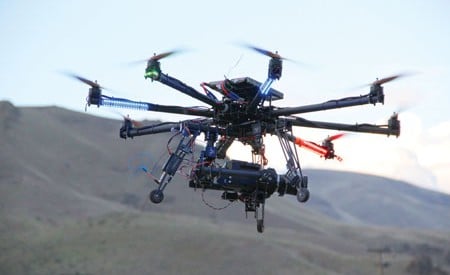We are now at the dawn of a new age: aerial media. Remote control helicopters, or Unmanned Aerial Vehicles (UAVs), are sweeping the world of action sports media. But UAVs also have another, more politically charged name: drones.
I have experienced UAVs first-hand this year while paddling for a video shoot. Remote control helicopters were used to capture never-before seen angles of paddling. It was quite incredible: waiting above a thundering rapid, radio in hand for the go-ahead, and then seeing a big octocopter with LED lights levitate above the whitewater mist and stabilize with the camera gimbal swiveling towards me. It definitely adds another factor to the adrenaline of running class V whitewater.
I was recently able to catch up with one of the best pilots (who chose to remain anonymous) in this nascent industry, and his passion was contagious.
“I enjoy this incredible combination of maintaining cutting-edge machines, exploring the visual arts, and revealing natural environments in ways that have never been seen before,” he said. “I get to combine technology, art, and the natural world.”
Whereas full-sized helicopters cost over $1,000 per flight hour and require transit time to access remote areas, UAV pilots and equipment can be hired for far less. They can also be launched and landed on rough ground, or even in an assistant’s raised hands, and maneuvered in tighter environments. The machines can be transported easily in the back of most vehicles, recharged repeatedly using electrical outlets, and are still capable of carrying up to 20-pound payloads. This allows for top-of-the-line cameras to capture stunning, groundbreaking footage. The final upside is environmental: these machines operate on electricity rather than oil, saving hundreds of gallons of fuel per shoot day. Sport by sport, the paradigm is shifting, and the perspectives coming from these machines are changing the game.
But there is a downside.
Federal regulations, pilot training, and best practices have yet to catch up with the technology. There has been one recorded death, and an assortment of injuries resulting from UAV pilots losing control of their machines. The driveshafts spin at over 8,000 rpm, meaning the blades are traveling at over 150 miles per hour. In the control of the wrong person, those blades can cut off fingers, take out an eye, or worse. Another concern expressed by the FAA is how UAVs will “sense and avoid” other aircraft. Many are capable of achieving altitudes of over 3,000 feet, meaning that with the growth of their popularity, it’s possible that there could be an aircraft/UAV collision.
The anonymous pilot fielded these concerns, saying: “I try to avoid jobs where I need to fly around crowds. Equipment failure can still occur, and the heli never leaves the ground if I feel uncomfortable. As far as collisions with aircraft go, most of what I do is under 100 feet off the deck. When I do need to go higher, my pilot’s license comes in handy with understanding airspace and how to stay out of the way. I don’t think these concerns are unfounded, but we need to use common sense in all aspects of life. I could do a lot of damage in my car too if I didn’t use common sense.”
While the U.S. military drone program is a source of extreme tension internationally, drones are also becoming increasingly prevalent as domestic security tools. They patrol the border with Mexico, gather perspectives of suspected drug operation houses, search for missing persons, and photograph traffic accident scenes. There is a large outcry by the general public about privacy rights, and this pot will only boil further as civilian drone use increases. It is now possible for all of us to have “eyes in the sky.” The technology is commoditizing constantly, and one company offers entry-level machines capable of carrying a GoPro for a reasonable $1,000 pricetag.
So what is the future of this new form of media?
Most UAV pilots out there approach their work with the same precision and diligence as they would if they themselves were in the machine. Unfortunately, the few bad apples will probably draw negative attention to the use of UAVs, and the regulations will come crashing down on pilots within two years. Commercial UAV work will require a heavy permitting process as authorities try to catch up on half a decade of obscurity, and it will become almost impossible to fly in federally controlled areas like national parks.
Regardless, UAVs are quite simply going to redefine how the public perceives outdoor sports, immersing the viewer more intimately in the sheer grandeur of dramatic environments. As you watch videos of your favorite sports, keep an eye out for aerial footage. Some of the most beautiful shots will be coming from drones.








